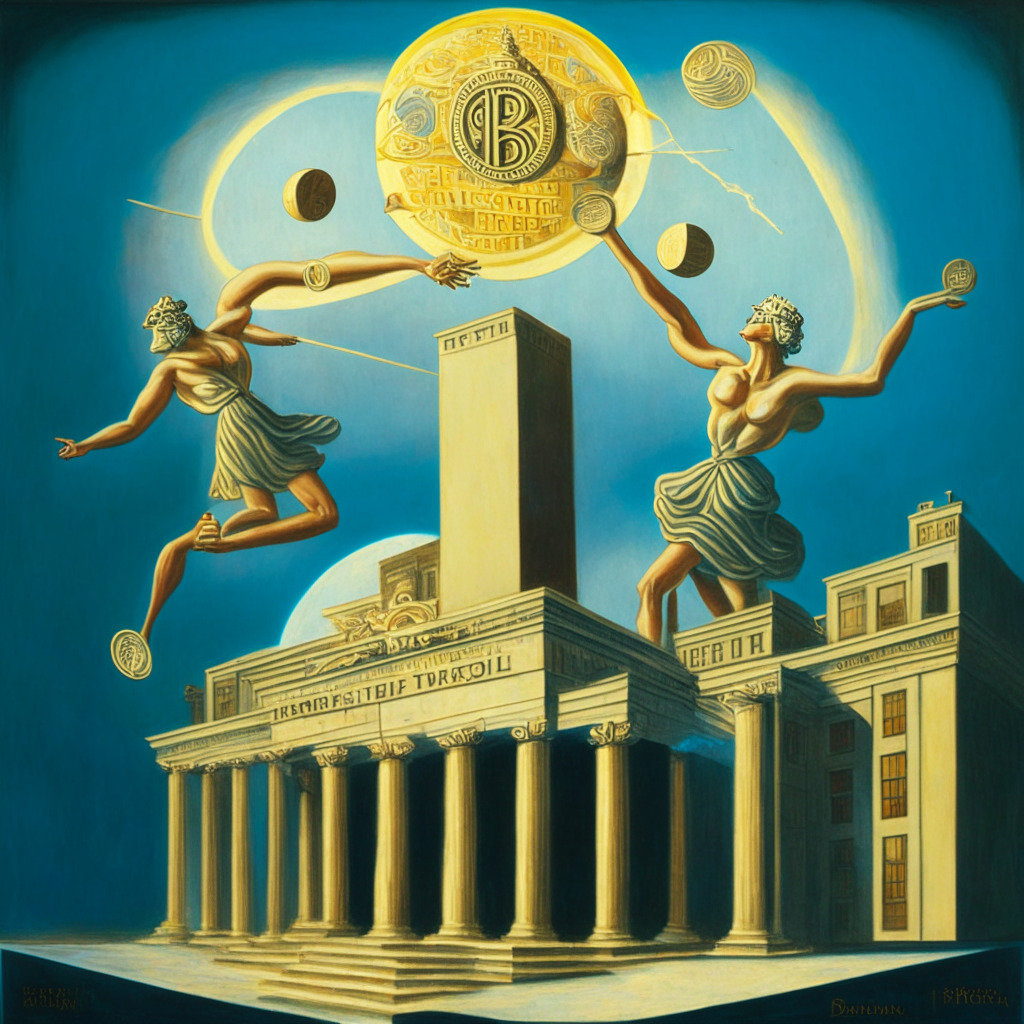Coinbase’s layer 2 blockchain, Base, sets record daily transactions, thanks to FriendTech, a decentralized social network platform built on Base. Despite a recent decrease, rekindled Base activity suggests network maturation. This strong start, unaffected by Ethereum’s congestion and fees, could indicate sustainable future growth with “layer-2” networks.
Search Results for: Base network
Revamping Ethereum’s Staking Infrastructure: Is SSV.network the Solution to Pool Decentralization and Key Security?
“SSV.network, in partnership with the Ethereum Foundation, recently launched its mainnet aiming to decentralize Ethereum staking pools. Leveraging Distributed Validator Technology, it aims to increase validator resilience, enhance private key security, and minimize the risks of validator downtime.”
Ethereum Staking Redefined: Decentralized Pathway Led by SSV Network Challenges the Norms
“ssv.network has introduced a blockchain solution emphasizing on liquid staking, aiming for a higher level of decentralization. Given the centralization concerns around Ethereum’s staking mechanism where top exchanges and selected entities hold majority of staked ETH, SSV’s mainnet proposes an approach to mitigate these problems. This new system, facilitated by SSV smart contracts, encourages multiple operators’ involvement without needing external coordination.”
Bridging Crypto and Traditional Finance: Ramp Network’s Adoption of Brazil’s Pix System
Ramp Network, a start-up providing payment infrastructure, adopted the Pix payment system of the Brazilian Central Bank fostering its penetration into South America. This integration not only increases accessibility to cryptocurrencies but also ignites market volatility concerns due to regulatory uncertainties.
Ethereum’s New Holesky Testnet: A Step Towards Optimized Network Scalability and Enhanced Testing
Ethereum is set to unveil a new testnet, Holesky, which promises larger capacity than its existing networks, Sepolia and Goerli. The new testnet aims to address potential scaling issues and accommodate more extensive testing for Ethereum’s growing developer community. Named after a Prague train station, Holesky’s significant size would provide a realistic environment for infrastructure and core protocol upgrade testing, targeting to enhance Ethereum’s resilience against unexpected obstacles.
Unpacking Telegram & Coinbase’s Crypto Integration: Boost or Bottleneck for Blockchain?
Messaging app, Telegram integrates a crypto wallet, available to its 800 million global users, potentially positioning it as a mainstream blockchain platform. Simultaneously, crypto exchange Coinbase integrates Bitcoin’s layer 2 payment protocol, Lightning Network, promising faster transactions. Despite apparent benefits, the integration process and exclusions pose potential drawbacks.
Coinbase’s Web3 Wallet: Bridging Institutions with On-chain Applications, But Is It Enough?
“Crypto giant Coinbase inaugurates a Web3 wallet primarily focused on aiding institutions to venture into NFTs and other aspects of decentralized finance. The wallet, under the Coinbase Prime division, offers a gateway to crypto, NFTs, decentralized apps, and a broader DeFi spectrum, while ensuring the safety and security of client’s assets.”
Manta Network’s Leap Forward: Gains and Regulatory Risks in Layer 2 Solutions
“Manta Network has launched its zero-knowledge proof layer 2 scaling network, an innovative platform for ZK-enabled DApp development. This introduces increased throughput and reduced gas fees, promising future DApps realm expansion. However, challenges and regulatory issues, as highlighted by the Celsius incident, suggest the need for careful navigation in blockchain tech.”
Navigating the Global Ambitions of Coinbase: Expansion, Investments, and Hurdles Ahead
“Coinbase’s ‘Go Broad, Go Deep’ global expansion includes acquiring licenses and enhancing market presence in regulatory clear countries like Europe, Canada, Brazil, Singapore, and Australia. It added six new projects to its Base Ecosystem Fund while cryptocurrency startup LBRY battles a legal charge brought by the SEC.”
Celsius Network’s Judicial Scuffle with EquitiesFirst: A Lesson in Crypto Trading Risks and Regulations
“Celsius Network, a bankrupted crypto lending company, is filing an “adversary complaint” against EquitiesFirst to reclaim its assets. Amid fraud allegations, ex-CEO Alex Mashinsky’s assets froze. Reportedly, EquitiesFirst owes Celsius $439m, part of which is repaid monthly in cash and BTC.”
Blockchain Boom: Story Protocol’s IP Ownership vs. Coinbase’s Crypto Lending Battle
“Story Protocol is using blockchain technology to empower content creators and oversee their content, countering falsified AI-generated content. Meanwhile, Coinbase has launched an institutional-grade crypto lending platform, Coinbase Prime. These high-value projects symbolize the maturing crypto technology space.”
Using Bitcoin’s Lightning Network for Offline Transactions: The Future or a Fallacy?
“LNMesh, a Florida-based startup, proposes the use of Bitcoin’s Lightning Network for transactions without internet. The solution utilizes local mesh networks for devices to connect directly, allowing for off-chain Lightning payments across nodes in an offline manner using Raspberry Pi computers.”
Decoding Aerodrome’s Sudden $150 Million Boom: An Analysis of Base’s Newest DeFi Phenomenon
Aerodrome, a collaboration between Velodrome and Base developers, raised $150 million less than a day after being released on Base. With the goal of replicating Velodrome’s success, Aerodrome offers AERO tokens to users who provide liquidity, conduct token swaps or participate in governance.
Tether’s New Link with Bahamas-Based Britannia Bank: A Boon or Bane for the Crypto Industry?
Tether, the issuer of popular stablecoin USDT, has established banking relations with Britannia Bank & Trust. This connection could streamline dollar transfers, improving Tether’s functioning within the traditional financial network. Britannia’s recent acquisitions and positive stance on crypto suggest this relationship is strategic for both entities, impacting the future of the crypto industry.
Coinbase: A Journey through Tech Glitches, User Experience Innovations, and Regulatory Challenges
Recently, Coinbase users encountered a bug resulting in the display of empty wallet balances, impacting the ability to add or import wallets. Despite setbacks including a 70% transaction slump and regulatory pressures, Coinbase continues seeing success, including a 156% stock gain this year.
Pioneering DeFi on Base: Aerodrome’s Launch with Promising Prospects and Steep Hurdles
“Velodrome has launched Aerodrome, a decentralized exchange (DEX) for Coinbase’s layer 2 blockchain, Base, aiming to deliver low fees and minimal slippage. This marks the start of the DeFi era on Base, stressing on transparency and rewarding users via airdrops of governance token, AERO. Despite facing challenges in a high-competition market, it signals ongoing innovation in DeFi.”
Clockwork Shuts Down: Is Solana-Based Protocol Future In Doubt?
“Solana-based smart contract automation project, Clockwork, has halted operations. Founder Nick Garfield cited ‘simple opportunity cost’ and minimal commercial benefits as reasons. The project had raised $4 million in seed funding but succumbed to challenging conditions. This has not impacted the standing or potential of Solana and its protocols.”
Ethereum’s Lower Network Activity: A Sign of Successful Scaling Solutions?
Ethereum’s gas fees have hit an 8-month low due to low network activity, yet layer-2 scaling solution popularity is on the rise. This indicates the vital role of scaling solutions in maintaining low fees even amidst growing decentralization. Notably, Ethereum 2.0 and layer-2 solutions seem to alleviate the issue of high adoption against expensive gas fees and slow transaction times. Ethereum’s evolving technology is making it increasingly invincible, even against rival blockchain platforms.
Blockchain Opportunities and Threats: Multichain Hack, Base-Optimism Collaboration and Shibarium’s Relaunch
Amid a $1.5 billion Multichain hack investigation and potential seizure of Multichain funds, Base and Optimism networks are expanding blockchain’s reach with initiatives in governance and revenue-sharing. Simultaneously, Quantstamp unveils a service to detect flash loan attack vulnerabilities, forwarding blockchain security.
Coinbase, Blockchain and the Tightrope Walk between Control and Decentralization
Coinbase recently launched “Base,” its own blockchain network, alongside its strategic framework, “Base Neutrality Principles”. The principles are designed to navigate the nuances of running a proprietary blockchain without compromising its decentralised nature. They include non-interference with crypto assets, transaction sequences, and ensures privacy and unhindered withdrawals for Base users.
Friend.tech’s Privacy Breach: A Concern for Social Network Tokenization
Friend.tech, a platform for tokenizing social networks, recently suffered a significant privacy breach. Data from over 101,000 users was disclosed on GitHub, including Twitter usernames linked to Base wallet addresses. This alarming episode has raised serious questions regarding data protection and privacy within the growing world of blockchain technology.
Coinbase Acquires Stake in Circle: Betting Big on Stablecoins and Shaping Cryptocurrency Markets
Coinbase has acquired a minority stake in Circle Internet Financial and both companies dissolved their Centre Consortium associated with issuing USD Coin (USDC). Amid greater regulatory clarity, Circle will become the sole issuer of USDC and control reserve governance, facilitating its integration on various blockchains. This shifting control indicates wider stablecoin adoption in the crypto economy.
Coinbase’s Curveball: Acquiring Stake in Circle and Impact on USDC, Coupled With Emerging Legal Battles and Friend.tech’s Surprising Growth
Cryptocurrency exchange Coinbase acquired a minority stake in Circle Internet Financial, causing the dissolution of their Centre Consortium venture, responsible for issuing USD Coin (USDC). Despite this, Circle plans to continue in-house issuance and governance of USDC, which is expanding its support network to include six additional blockchains. Notably, no cash was involved in the transaction between Coinbase and Circle.
Shibarium Stumbles: The Trials, Triumphs, and Tough Lessons in Launching a Blockchain Network
“The Shibarium network of Shiba Inu recently faced a significant setback when an unforeseen user transaction surge led to transactions stalling for 11 hours post-launch. Despite initial hiccups, developers hope for successful reopening, utilizing new monitoring systems, auto server resets, and rate limiting to manage future traffic surges.”
Decentralized Social Network Friend.tech: Astounding Success or Potential Disaster?
“Decentralized social network Friend.tech quickly earned over $1 million in fees, outperforming giants like Uniswap and Bitcoin. However, concerns loom around its business model, potential exploitation, and data privacy, raising questions about its future sustainability and growth.”
Shifting Tides of Cryptocurrency: Shibarium’s Shaky Launch and Coinbase’s Future Opportunities
“The cryptocurrency market recently suffered a steep value drop in SHIB, BONE, and LEASH tokens due to suspected technical issues in the newly launched Shibarium network. Despite anticipated increases pre-launch, SHIB, BONE, and LEASH experienced decreases of over 8%, 14%, and 23% respectively.”
Shibarium Network’s Rocky Launch – A Setback for Shiba Inu’s Blockchain Ambitions
“The Shibarium network, highly anticipated by Shiba Inu token holders, faced significant technical issues upon launch, causing a halt in transactions and a dip in SHIB’s value. This has raised concerns about blockchain vulnerabilities, particularly as Shibarium was part of a larger strategy to elevate Shiba Inu from a “meme coin” to a serious blockchain contender.”
Scammer’s Paradise? Investigating Security Setbacks on Coinbase’s Base Platform
Recently, a crypto lender, SwirlLend, scammed the newly launched Base platform, resulting in a significant loss of cryptocurrency and trust. This incident, second in a few days, has raised security concerns and emphasizes the necessity for robust cybersecurity measures in the crypto realm.
Coinbase Unveils Stand with Crypto Alliance: The Push for Unified Regulatory Clarity
Coinbase has launched Stand with Crypto Alliance, an independent non-profit seeking to advance the interests of the growing crypto community. Amid regulatory battles, this entity aims to rally the decentralized community towards legislation that shelters consumers and safeguards their crypto rights while fostering innovation. Coinbase’s move marks a significant shift towards legislative matters.
Coinbase’s Steadfast Endeavor: Future of Crypto Adoption Amid Regulatory Challenges
Coinbase, amidst falling trading volumes and revenue, is focusing on the future of crypto by launching a new blockchain. Key adoption aspects under discussion include blockchain scalability, non-financial crypto use utility, and navigating crypto regulation. The company advocates social solutions to resolve tech-related issues and is leading efforts to influence crypto-specific U.S. legislation through its nonprofit, Stand With Crypto.
Rising On-Chain Activity Exposes User Experience Flaws in Coinbase App
Brian Armstrong, CEO of Coinbase, has recognized major user experience flaws within the Coinbase app. These issues emerged during the surge in on-chain activities on the layer-2 network, Base, particularly involving NFTs, Dapps, and Layer 2 solutions. Despite significant improvements, Armstrong admits much work remains and welcomes user feedback for prioritized resolution. This revelation underlines the importance of app usability and user experience in the volatile crypto world.
Exploring Base: Coinbase’s Layer 2 Blockchain Phenomenon and Its Potential Unraveled
Base, an Ethereum layer 2 blockchain developed by Coinbase, has attracted over $10 million and 15,000 tech enthusiasts on its launch day due to its open-source nature, allowing others to build or launch tokens on it. However, it faces potential security concerns and debates over long-term customer engagement strategies.































